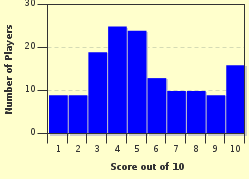Quiz Answer Key and Fun Facts
1. Which of the following was manufactured by DEC?
2. What was/is an acoustic coupler?
3. What was/is a TWX-33?
4. What numeric base system was used by the Honeywell-800?
5. WATFOR (Waterloo Fortran), first delivered in 1965 by Waterloo University, Ontario, Canada, for the IBM 7040 was a watershed in programming language development. Who was the original development team?
6. Ferranti-Packard (subsidiary of British ICT) sold a moderately successful computer, complete with compilers and operating system, the Ferranti-Packard 6000 in 1963. The first of these (serial number 0001) was retired in 1982. To whom did they sell this first machine?
7. Early mainframe computers used water cooling.
8. Gene _______ left IBM to open a competing mainframe company.
9. Mainframe computers are no longer manufactured.
10. The practice of drawing felt marker diagonal lines in various colours along the top of your computer card decks was done for what reason?
Source: Author
key_man
This quiz was reviewed by FunTrivia editor
crisw before going online.
Any errors found in FunTrivia content are routinely corrected through our feedback system.

